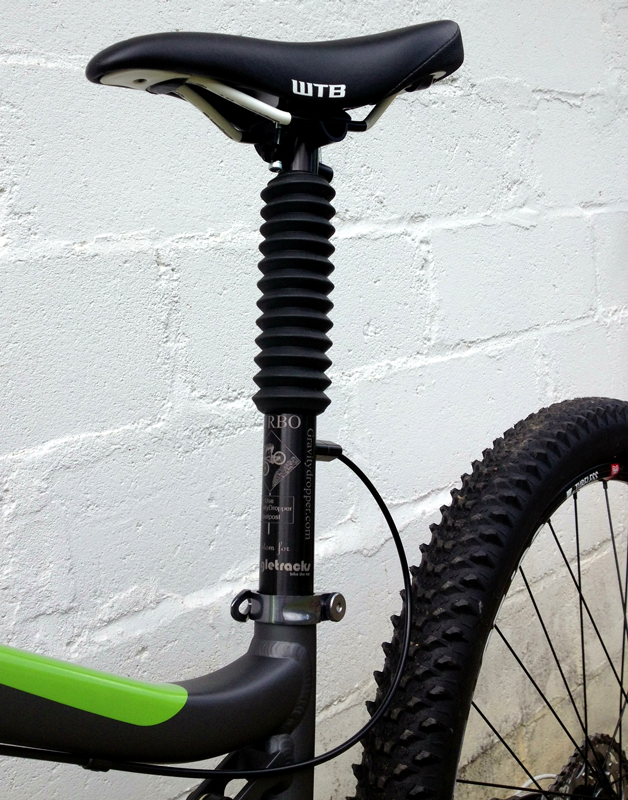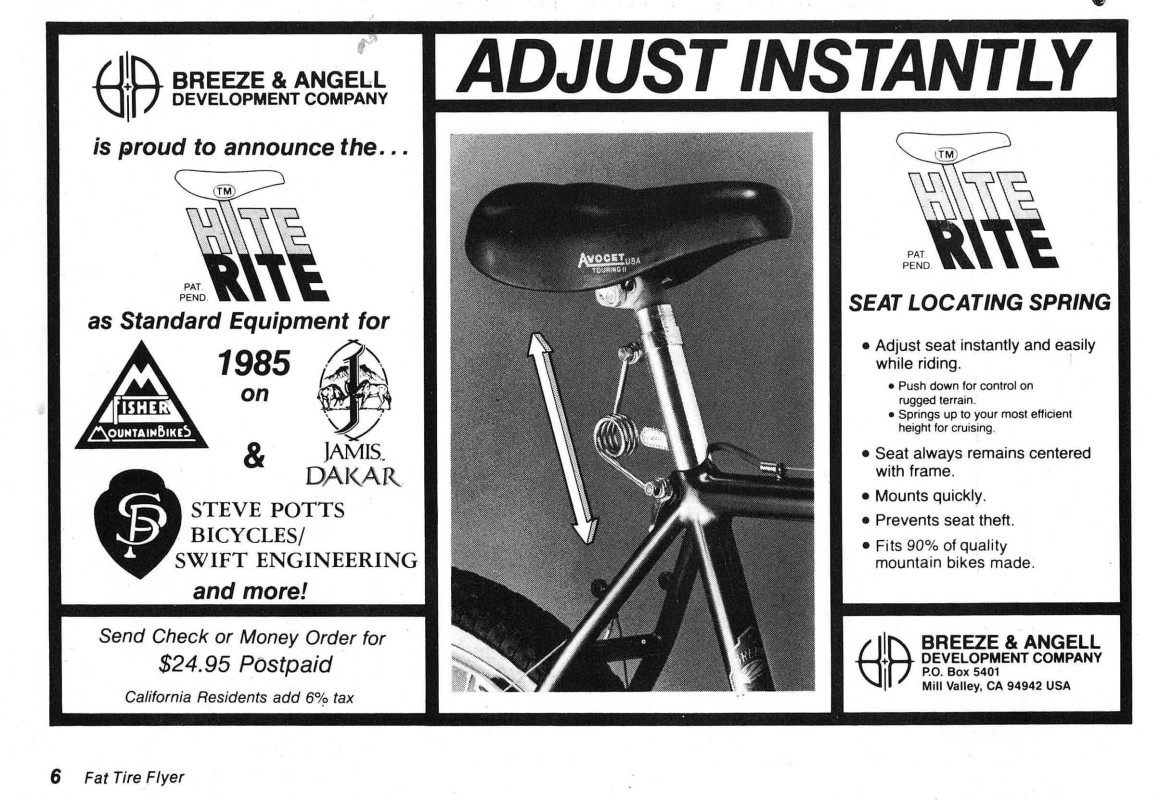This is a question that has been on my mind for the last decade, how much stroke do we need in a dropper seatpost? It’s not a new question but a good one to ask now and then. It’s a moving target. As we speculate on what we need, then eventually use that, our position changes with the new information.
Let’s start with some context.
Way way back, near the klunker era, while people were figuring out what it meant to ride bikes as sport on narrow off-road trails, folks had found that a high post was great for making power going up the hill but for going downhill and rugged traverse we needed the saddle somewhat lower. A rider could fiddle with box end wrenches at the top of the hill before going down or just work around the high saddle at their peril.
Soon, a quick release lever was added to the seat tube binder to eliminate the need for fussing with tools. Joe Breeze even tried to solve the problem of quick ‘on the fly’ adjustment with his Hite-Rite mechanism. That all didn’t really work well and we were left using the quick release lever or tools for the next 25 years. Some riders, “to save weight” and terrified to change their saddle height, just kept the saddle full high all the time.
I’ve been riding challenging trail since around 1989, and I’ll tell you, the quick release lever in this placement didn’t work very well. The mechanism would gaul or slip. You still had to stop and get off to make the change. It was more fuss than anything else. The folks I rode with and myself gave up on them and would just pull a 5mm hex wrench out and change the saddle height before going downhill, then raise it again at the bottom. That really worked better than any other option. The folks that left their seats at full height wouldn’t bother with any of this but they never learned to ride trail well.
Also, in those days, we were often left to ride trail with a saddle a little lower than optimal so that we could ride most of the technical features on single track and also pedal up the hills. It was terrible. The folks that weren’t having an issue with this weren’t really trying to do much other than pedal on fire road.
The moment this changed, in my eyes were the confluence of two of the legendary cycling features in NorCal during the 1990s and 2000’s was the Downieville Classic and a man named Mark Weir. Back before we had Enduro or Super D racing in the United States, there was the Downieville Downhill. This race has become one of the real classics of dirt racing and back then, it was something very very different. Billed as a ‘downhill’ race, it wasn’t. What it was was 15 mile race that dropped about 5,000 feet with several climbing sections over the course. It could be done in under an hour if you were a decent rider and under 50 minutes if you were a really good rider. For the first 10 years of this event, Mark Weir owned this race. Mark was one of those special riders that could ride at a professional level in cross country or downhill but if you mixed the two together, nobody could touch him. Mark also had another thing that made him great, he would train harder than anyone and try anything that would make him better. Mark had the first pump track that I ever knew about. He would always have some bit of hardware to try and it was always a treat to look at his bike.
One year, Mark showed up to the race with something different, a Gravity Dropper seatpost. It was always the talk of the town as to what Mark was going to ride for the race and this made for a lot of talk. For what this race was, this seemed like the ultimate weapon. I’m certainly not saying that Mark invented this device but him riding it at Downieville gave it the legitimacy that was needed for others to seriously try it.
Those early dropper posts weren’t the best things you’ve ever seen. They were spring loaded and could hurt you if you released the tension at the wrong time. They were indexed for 2 or 3 positions. They were clumsy and had a lot of issues. They were heavy and had a really goofy cable arraignment, but they really did do something new.
In 2009(?) Rockshox released a much more refined dropper post to the market, the Reverb 125mm. It had an external hydraulic line that was a little better than the Gravity Dropper posts but the action was smooth and infinitely positioned. They were instantly the ‘must have’ part for anyone participating in Super D and primordial Enduro events. They were problematic. I was dating a pro enduro racer at the time and we had to rebuild her post every other week. Folks wonder how I became such an expert on dropper posts and this is where it started. Since I wasn’t racing these events or much at the time so I choose to wait for a more durable design before spending on these. 125mm of stroke was really good then as you only had a rigid post to compare it to. Everything was opening up.
Over time, designs improved and ‘stealth’ routing was added to any of the competitive seatposts. Also, a little more stroke, the 150mm KS LEV Integra became the new ‘go to’ post. It was cable actuated, infinitely adjustable, and a lot more durable than the early Reverb A1 posts. The routing into the seat tube was much improved (RS had this on some early Reverbs but only as a Trek OEM part) The 150mm stroke was really getting into the range of what we needed on the trail.
Time went by and the next star was the 170mm A2 Reverb. If 150mm was good, 170mm should be amazing…and this was true. Anyone moving from a 150mm post to a 170mm post never looked back. It just opened up more. Riding with anything less than 170mm of stroke is strictly for road bikes.
This was around the time where frame design and geometry really started holding everything back. We can blame novice designers and the cost of carbon fiber molds for this. Carbon fiber frame production costs have done more to hold back mountain bike development in recent memory than anything I can think of. The dropper seaptpost had really started to change the shape of a performance bike and many companies were years late selling frames that were optimized for their use and even had space for longer strokes. Some still don’t get it, especially in the custom market. It’s better now in MTB but the gravel market is still terrible.
For years, frame brands have been pushing against longer stroke droppers to slow the need for change. Even at the retail level, shop employees would be told that 125mm of stroke was plenty, despite anyone that did try a 150 or 170mm stroke totally disagreeing. Selling crap was far more important than producing better bikes and the marketing departments worked hard on this.
My frame designs and geometry had already been optimized with plenty of clearance for long droppers in 2017. Even then I could have used a 280mm dropper were one available. This is still true. That I could run anything meant that I could always use what I felt best. Almost all others were restricted to 150mm or less until as recent as 2019. Even now, most bikes don’t have room for over 170mm.
A new player lands, the 185mm BikeYoke Revive. Back in 2017, the question was, do we really need more than 170mm of stroke on a dropper post? To answer that, we got our hands on a batch of 185mm Revive posts. The Revive is honestly, the nicest functioning post of all I’ve ever used. It’s incredibly smooth and easy to move. In testing, I found that while the extra 15mm of travel made it a lot easier to re-mount the bicycle on steep technical sections, while actually riding on the bike 170mm was really fine and enough.
When the 210mm OneUp V2 came to market, things were changing. Dropper prices were going down. It was time to be a little more frivolous with purchases. This post was pretty cheap so I figured what the hell, go for broke. The post works well enough give it’s price. Not as pristine as the BikeYoke, it requires a bit more effort to move. Time has proven the OneUp V2 post to be extremely durable. I have yet to have an issue with the adjustment functioning. I will say that it does need regular servicing to keep functioning at a top level as the lubrication seems to pump away from vital areas.
At first, the 210mm stroke seemed like a lot. Basically, I’d be over dropping, forcing me to put a lot of effort to get back up. On the bike it didn’t seem like there was so much to gain over the 170mm but having plenty of room when in the rough was nice. There wasn’t a ton of gain with the 25mm additional stroke from the 185mm post other than it was super nice for re-mounting the bike on rough sections and more freedom. The increased effort getting up was a little bit of a pain.
So I decide to stay with the 210mm stroke post for a year on several of my bikes. What the hell?! In time, I get more used to it and it becomes familiar. I adapt. What I notice is that the way that I’m cornering has been changing. Not in the rough, but the smooth. I’m getting lower and just able to start crossing over my saddle under my thighs. It’s more like a technique from sport bike then bicycle riding. It’s helping a lot especially on flatter looser corners. It comes in handy in other places also but I think that this is where it shows up the most. This change in technique really is something new and very good. It took time to start seeing this.
Surprisingly, I’m now thinking that more IS what we need, not less. A 225-230mm post may just do it (for a 5’10” rider). The goal is to be able to cross my thigh over the top of the saddle easier and hook the back of my knee on it. That’s where I’m thinking this will be going.
Isn’t this funny. A development that made it easier and faster to go from smooth to rough trail, ends up speeding up smooth corners. Testing and time with a little context always helps. I’m now excited to get on something longer than 210mm.


